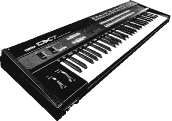Electronic Equipment in Pop and RockToday there are an incredible number of different genres within popular music; pop, rock, hip-hop, dance, techno, jungle, ambient, industrial, etc. Common to all of these is the use of different forms of electronic instruments, computers and programs to make music. Technology became increasingly advanced during the 1980s while prices went steadily down. This has enabled more people to experiment with and use technology, and many things that were formerly possible only in expensive studios are now possible to do at home.
When the Beatles recorded "Sgt. Pepper's Lonely Hearts' Club Band" (1967) it was not as simple to make recordings as it is today. The Beatles, who until then had been part of making rock and pop what it was, wanted to do something new with their own music. The methods used by the band during the recording of this album was to revolutionize popular music. They broke all of the rules for how to make recordings and created a sound in their music that would have been impossible if they had only used "normal" instruments (drums, bass, electric guitar, etc.).

They recorded sounds backwards, used tape loops, dog whistles, Melotron, early synthesizers - they even considered having John Lennon hang from the ceiling by a rope and twirl around while he sang in the microphone in order to get a "rotating" effect on the vocals. Luckily, today we don't need such drastic tactics to achieve such effects. Most of the effects that the Beatles made on that record can be done by means that are far more simple, by using a sampler, for example, or a computer.
A similar desire to find new methods and approaches in music exists today as well. Popular music is always trying to give the listener something different, and new trends are created all the time. When samplers became widely accessible, a whole new world of sound was opened. Now practically any sound imaginable could be placed in a musical context. Yet it must also be said that although the sampler, for example, has allowed for many new and exciting sounds, it has also led to what at times seems to be assembly-line music, full of clichés.
Many of the genres within popular music would not exist without the technology we have today. Techno music is a good example of this, where

synthesizers, samplers, digital effects and computers are used to create sounds and rhythms that one could not have created using "normal" instruments. You may sample any sound at all, treat it in a computer and then place this sound wherever you want in the music, for example, use it as a bass drum. In addition, all of these instruments may be controlled by a computer through MIDI. You don't need to be able to play an instrument in the traditional sense, only to give instructions to the computer as to where you want the different sounds (instruments) to play. If there is something you are not satisfied with you can change it at any time.
Rap and hip-hop music also use many of the same working methods as techno music, and have even turned the record player into an instrument. Scratching is actually an old technique, which was first used in France right after WW II. IN DSP you can find a program called "Sctrach". In this program you may experiment with this effect yourself.
Most musical forms do not use technology to the same degree as techno and rap music. Pop and rock music often use familiar instruments such as guitar, bass and drums, and here technology is useful in different ways. Acoustic drum sounds may be recorded in a computer, for example, and the drumbeats later moved or adjusted if you want them more rhythmical. All of the instruments may be worked with in this manner. You can copy a vocal in a refrain and place it in the next refrain. Many artists also record elements on the computer at home (synth sounds, samplings, drum rhythms). They then use a professional studio to record acoustic instruments together with what they have on the computer. Many studios have a computer linked to the mixer as well, enabling them to record adjustments that had been made (volume, filtering, effects, panning) in different places in the music. In this way, one is able to return to the studio and continue the next day without having to remember everything that was done the day before. The computer remembers it for you.
Even though technology has created a multitude of new possibilities, many artists are beginning to be concerned about music becoming too mechanical and impersonal. Many believe it is becoming too perfect! This has led some artists to seek back to a genre's "roots" for inspiration and ideas. Others have thrown out their digital synthesizers and samplers for old analog synthesizers and effects from the 60s and the 70s. Increasingly more recordings are made using live musicians, and rock and pop are frequently played "live" in the studio. This demonstrates that machines cannot replace people, and that there is now a more reflected use of machines.
|
|
|